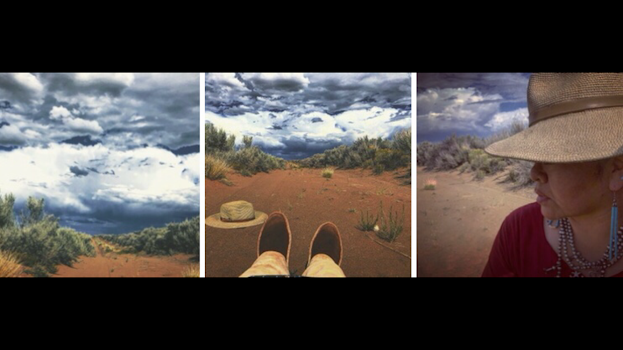 |
My late maternal grandmother, Jane Werito Yazzie
ALL RIGHTS RESERVED
Venaya J. Yazzie |
Five months have passed since I lost my grandmother. Everyday I wake up and begin the process of missing her again. Every moment I experience now, I think about how she would have reacted to it. I find myself planning my daily activities as if she was still physically present on earth. My brain is confused and seems to be constantly trying to keep up with the ever-changing status of my spirit. To be honest my heart is broken, I am broken.
I lived a full life with her with me. She was always by my side. She was my rock, my muse. Now that she has traveled on to the next world, I am here existing in what feels like a cloud.
My late maternal grandmother, Jane Werito Yazzie was my best friend. We were more than forty years apart in age yet we were similar in many ways. We loved the same things in life, we talked the same, were amused by parallel things. Together, as grandmother and adopted grand-daughter, we faced the joys and challenges of Navajo life in the Four Corners community. "Mom" passed on from this life on earth to the next world in early February of this year and since then, my life has been a struggle.
As an artist I have sought out the possibility to get "inspired" again, but it has not been easy. In the last five months I found myself leaning on Art, but not being totally aware I was. What I have found is that many of the avenues of art, including the 'process' of art are taken for granted. I know that I am guilty of this too.
After this trauma of loss of a beloved matriarch, I realize that art should always be considered as a means of perpetuating the human / emotional, spiritual healing process. I have wondered among the many online art galleries of global artists and I have created my own home gallery of artwork from Indigenous artists I have collected through the years. What were my intentions of these activities? By doing these tangible things, did I think they would hopefully fill the emptiness and loneliness I was experiencing? Today I am pondering these kind of questions, and am still asking myself. What is my purpose as an artist?
In the five months since her passing, I have come to the realization that I have been able to work through my mourning of her. This personal journey of healing has been initiated through all the months of the grieving process by unconsciously living the life of a multi-media artist. I can truthfully express that art saved me, and that today art is healing my broken spirit! The concepts of art as therapy have worked as a spiritual source for me. My awareness of art as a therapuetic act has allowed for me to find some balance again. My work as a painter and multi-media artist has steered me be in my studio for several hours a day. In that space of art tools and the art itself has brought me to a state of being that is tolerable and my creative flow of energy and thought is becoming clearer day by day. In my research of grief after the death of a loved one I have learned that it has 7 stages. They are fully emotional and include: shock (disbelief), deniel, bargaining, guilt, anger, depression and acceptance and hope.
So, where do I think I am existing within this paradigm of the human grieving process?
Well, I am consciously aware that I have accepted the death of my grandmother. I know though that there is now set time of when mourning and grief will end or can be cured. I know that I carry hope now, that because of my belief of the spiritual existence of the Creator God, I believe I will see her again in the afterlife.
Art as therapy is a concept realized this week. I see that the art-way is wholly ingrained within the Navajo material culture, but moreover, it is rooted in the Navajo Philosophy of 'Iina' - Life. This was evident in my family through the women of my immediate and extended family, who in act existed as 'Creatives.' They lived lives of women artists. This is a profound realization for me! For example, my great grandmother who was born in 1907 was an avid weaver of traditional Navajo rugs and blankets. She was also an extraordinary seamstress. My grandmother Jane also encompassed these traits and they both passed on this ways to me. For that I know my life is blessed indeed!
My goal now is to continue doing my art in every aspect that I feel is relevant for me to continue healing my heart and spirit. My grandmother Jane gave me all of the goodness of her life, she was living a life with me in mind and now in adulthood I am living those ways through the Arts. I know I will still have the bad days, the sad days and the grief will still linger, but as an artist I know that the one constant is my art.
I pray for blessings all around me. And too, I pray for blessings all around you.
Venaya












